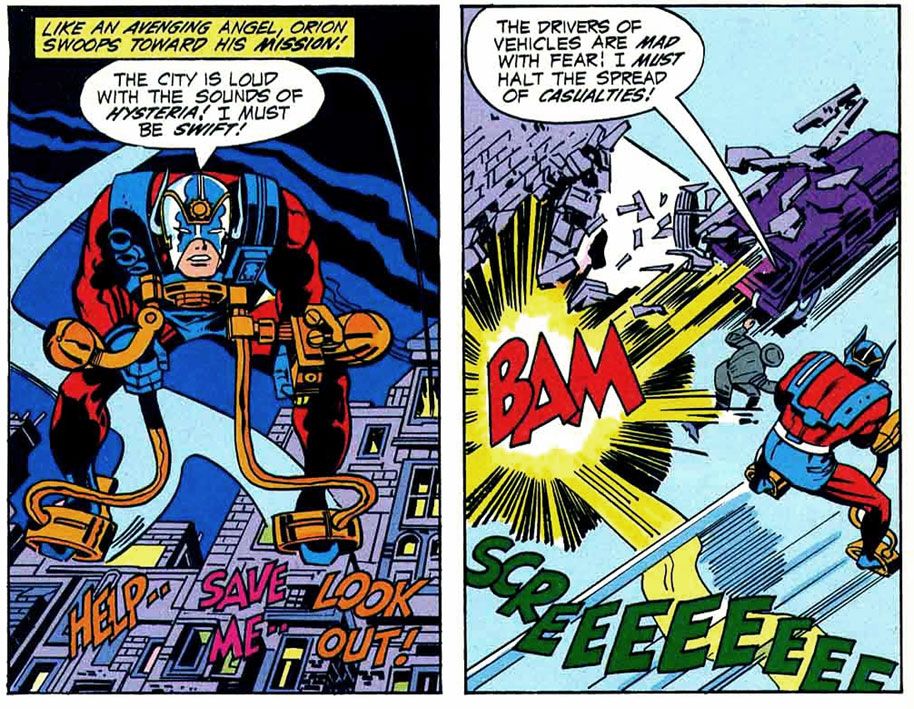Part One: The Epic Rhythm of Kirby
I picked up Jack Kirby’s Fourth World Omnibus after reading Joel’s write-ups about the Kamandi sets. I would like to be able to say I was revisiting old favorites, but the truth was I had never cottoned to Kirby during my developmental collecting days. I had preferred the clean lines of Byrne and the baroque richness of Perez and Jim Starlin. The expressionistic outbursts of Kirby (and Carmine Infantino and Steve Ditko) were wasted on the feckless youth that I was.
So, lame though it was, at the age of forty-five I finally found my way into Kirby via this set collecting The New Gods, The Forever People, Mister Miracle, and Superman’s Pal, Jimmy Olsen. I’ve read through volumes one and two and part of volume three. My mind is blown.
 |
| Jack Kirby, words and pencils/Vince Coletta, inks (New Gods #2, April-May 1971) |
Something different is happening here. Part of it is timeless. We call things “epic” all the time these days. If something is loud, long, and spectacular it’s an epic. The Fourth World Omnibus is intentionally and genuinely epic – sharing traits with the first epics, The Iliad and The Odyssey.
The characters are extraordinarily broad. Orion is war. Scott Free, like Odysseus, is cleverness. They have no inner life. There is no psychology going on here, no soap opera. That may seem like a criticism – “The characters have no inner life?” – but within this context, the stories and characters ring absolutely true. Just as the ancients were entranced by their own epics, these stories are completely engaging. Like, I’m falling asleep reading them because I can’t intentionally put them down to go to sleep. I haven’t liked a comic that much in years.
Other similarities to the epics? There is a complete absence of irony in Kirby’s work. It’s playful, absolutely. There’s plenty of humor. But there’s no knowing sarcasm, world-weary snarking, or irony. Also, the geography of these books is mythologically general. We find out at some point that the New Gods stories are taking place in Metropolis, but throughout, it’s simply referred to as “the city.” Which city? I don’t know, reader, could it be your city.
The Jimmy Olsen stories take place in a cavern underneath Metropolis that is so large that it has a number of distinct regions (the Wild Area, the Habitat), and a highway (the Zoomway) so lengthy that an RV the size of an apartment block can drive the highway perpetually. That sounds like something out of Paul Bunyon stories. The writers of the epics knew about the rule of cool, and so did Kirby.
 |
| Jack Kirby, words and pencils/Vince Coletta, inks (Superman's Pal, Jimmy Olsen #136, March 1971) |
But they weren’t writers; they were singers, and here’s where I’m going to go out on a limb about Jack Kirby. His work has rhythm. His lines, more than any artist I know, create the illusion of motion, and that motion – within a panel, from panel to panel, page to page – drags you along like a great dance tune, or an extravagant opera, or an epic being sung by a blind poet – a blind, maybe heavy metal poet.
And it is the lines that carry the rhythm for Kirby. It isn’t the events of the story, or the pace of his plots. It’s the drawings themselves. The Fourth World stories, really, are relentlessly violent. Kirby loves his fight scenes, and so do we. His characters are a troupe executing a very distinct choreography.
You can witness the truth of it when the rhythms of his lines are interrupted. In the Jimmy Olsen stories, DC had another artist re-draw the face of Superman over Kirby’s pencils so that this Superman would match the “typical” DC-brand Superman. It throws off the entire panel! It inserts a bland and lifeless and boring (in a Kirby work!) element into something wild and spectacular; a dollop of oatmeal in the middle of a bowl of kick-ass curry. Look at the un-inked pages, included as an appendix in volume 2. The Superman panels take on a new life. The Superman content suddenly makes sense in the Kirby context.
 |
| Jack Kirby, words and pencils/Vince Coletta, inks (Superman's Pal, Jimmy Olsen #133, October 1970) |
Kirby’s epic rhythm became even more vibrant when Mike Royer took over inks from the indifferent Vince Colletta. Is this akin, maybe, to production value? As I move through the third volume I am drawn further and further into this story in which, when the Gods finally come to Earth, it’s a complete disaster. I’m drawn by the events, by the writing, the characters, the amazing well-spring of ideas – something new every issue – but I’m mostly drawn in by Kirby’s lines and their rhythm.
Part Two is here!
Gary Chapin usually blogs about French accordion music over at www.accordeonaire.blogspot.com.

No comments:
Post a Comment